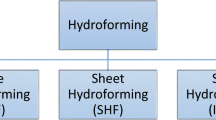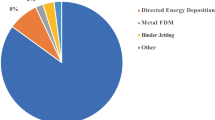Abstract
A new blank holder divided into double rings is proposed, in which the blank holder force (BHF) can be independently and effectively applied on different flange regions. In this paper, the principle and characteristics of the new blank holder technique are expatiated by theoretical derivation and stress analysis. All results indicate that the distribution of BHF applied by the double rings blank holder is more reasonable than a single blank holder under the condition of proper parameter selection, and the wrinkling can be better suppressed. The effectiveness of the double rings blank holder has been proven by deep drawing experiments. Using the new blank holder technique, the flange wrinkling was demonstrated to be more eliminated than that using the single blank holder. Moreover, experimental results also corroborate that the parameters of BHF distribution ratio and the boundary diameter of the two rings have a great influence on the effects of the new blank holder technique.














Similar content being viewed by others
References
Obermeyer EJ, Majlessi SA (1998) A review of recent advances in the application of blank-holder force towards improving the forming limits of sheet metal parts. J Mater Process Technol 75(1/3):222–234
Zhao SD, Zhang ZY, Zhang Y, Yuan JH (2007) The study on forming principle in the process ofhydro-mechanical reverse deep drawing with axial pushing force for cylindrical cups. J Mater Process Technol 187–188:300–303
Irthiea IK, Green G (2017) Evaluation of micro deep drawing technique using soft die-simulation and experiments. Int J Adv Manuf Technol 89:2363–2374
Senior BW (1956) Flange wrinkling in deep-drawing operations. J Mech Phys Solids 4(4):235–246
Hill R (1958) A general theory of uniqueness and stability in elastic-plastic solids. J Mech Phys Solids 6(3):236–249
Alizad-Kamran M, Hoseinpour-Gollo M (2017) Theoretical and experimental investigation of hydro-mechanical deep drawing of hemi-prolate spheroid cups. J Braz Soc Mech Sci 39(12):5181–5194
Yu TX, Johnson W (1982) The buckling of annular plates in relation to deep-drawing process. Int J Mech Sci 24(3):175–188
Yagami T, Manabe K, Yamauchi Y (2007) Effect of alternating blank holder motion of drawing and wrinkle elimination on deep-drawability. J Mater Process Tech 187:187–191
Kergen R, Jodogne P (1992) Computerized Control of the Blank Holder Pressure on Deep Drawing Process. SAE paper No.920433, Warrendale, PA
Hardt D, Fenn R (1993) Real-time control of sheet stability during forming. ASME J Eng Ind 115:299–308
Sim HB, Boyce MC (1992) Finite element analyses of real-time stability control in sheet forming processes. J Mater Process Technol 114(1):180–188
Siegert K, Doege E (1993) CNC hydraulic multipoint blankholder system for sheet metal forming presses. CIRP Ann-manuf Techn 42(1):319–322
Morovvati MR, Mollaei-Dariani B, Asadian-Ardakani MH (2010) A theoretical, numerical, and experimental investigation of plastic wrinkling of circular two-layer sheet metal in the deep drawing. J Mater Process Technol 210(13):1738–1747
Li MZ, Cai ZY, Liu CG (2007) Flexible manufacturing of sheet metal parts based on digitized-die. Robot Cim-int Manuf 23(1):107–115
Murata A, Matsui M (1994) Effects of control of local blank holding forces on deep drawability of square shell. Proceedings of the 18th biennial congress IDDRG. International Deep Drawing Research Group Working Group, Lisbon, Portugal, 207–216
Manabe K, Yang M, Teramae T, et al (1996) Development of a square-drawing simulator with cellularly divided blank holder control system. Proceedings of the 19th biennial congress IDDRG, International Deep Drawing Research Group Working Group, Eger, Hungary, 101–108
Hassan MA, Suenaga R, Takakura N, Yamaguchi K (2005) A novel process on friction aided deep drawing using tapered blank holder divided into four segments. J Mater Process Tech 159(3):418–425
Hassan MA, Takakura N, Yamaguchi K (2003) Friction aided deep drawing using newly developed blank-holder divided into eight segments. Int J Mach Tools Manuf 43(6):637–646
Gavas M, Izciler M (2005) Design and application of blank holder system with spiral spring in deep drawing of square cups. J Mater Process Tech 171(2):274–282
Thiruvarudchelvan S, Tan MJ (2007) Fluid-pressure-assisted deep drawing. J Mater Process Technol 192–193:8–12
Fukui S, Yoshida K (1954) The scale effects on deep-drawing of circular shells. Report of Science and Technology Institute. University of Tokyo 8:23–30
Qin SJ, Xiong BQ, Lu H, Zhang TT (2012) Critical blank-holder force in axisymmetric deep drawing. T Nonferr Metal Soc 22(S2):239–246
Tseng HC, Hung CH, Huang CC (2010) An analysis of the formability of aluminum/copper clad metals with different thicknesses by the finite element method and experiment. Int J Adv Manuf Tech 49:1029–1036
Acknowledgements
The authors are pleased to acknowledge the financial support of National Natural Science Foundation of China (No. 51175451) and National Natural Science Foundation of China (No. 51675466). The work is also supported by the Science and Technology Research and Development Program of Qinhuangdao city (No. 202004A005).
Author information
Authors and Affiliations
Corresponding author
Ethics declarations
Conflict of interest
The authors declare that they have no known competing financial interests or personal relationships that could have appeared to influence the work reported in this paper.
Additional information
Technical Editor: Adriano Fagali de Souza.
Publisher's Note
Springer Nature remains neutral with regard to jurisdictional claims in published maps and institutional affiliations.
Rights and permissions
About this article
Cite this article
Zhang, H., Qin, S. & Cao, L. Investigation of the effect of blank holder force distribution on deep drawing using developed blank holder divided into double rings. J Braz. Soc. Mech. Sci. Eng. 43, 284 (2021). https://doi.org/10.1007/s40430-021-03003-7
Received:
Accepted:
Published:
DOI: https://doi.org/10.1007/s40430-021-03003-7




